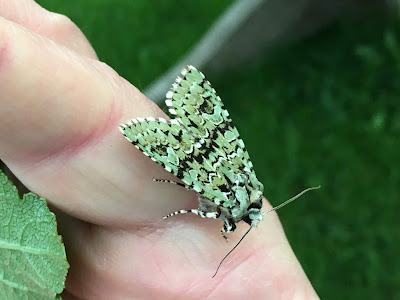Thank goodness for the clocks going back! Not just for the cosy, extra hour's sleep but because of a return, however brief, to lighter mornings. I had almost given up trapping because of the gloom at morning teatime. Now I have the heart to go on a little longer.
Although this post starts with a small tribute to the moon, shining brightly by both night and day, the real current star is below: the lustrous Green-brindled Crescent. Its season coincides with that of another top green moth, the Merveille du Jour which I featured ecstatically a few posts ago.
The GBC has the distinction of two different but both attractive forms; the standard one which has plenty of green, and the browner f.cappucino which is brownish, as its name suggests. Look closely, though, and you will see that the cappucinos have their own dusting of iridescent green scales, caused by the reflection and refraction of light.
Here, as a reprise, is a further tribute to the MduJ, making friends with my appreciative and moth-minded granddaughter:
And here are some other recent arrivals: a couple of Sallows, a Mottled Umber and Snout in the quartet and then a Silver Y and a Red-green Carpet, a traffic light among moths.
Finally, for now, we have a couple of Yellow-line Quakers, a late Autumn species, and a quartet of November moths whose name explains everything.














































